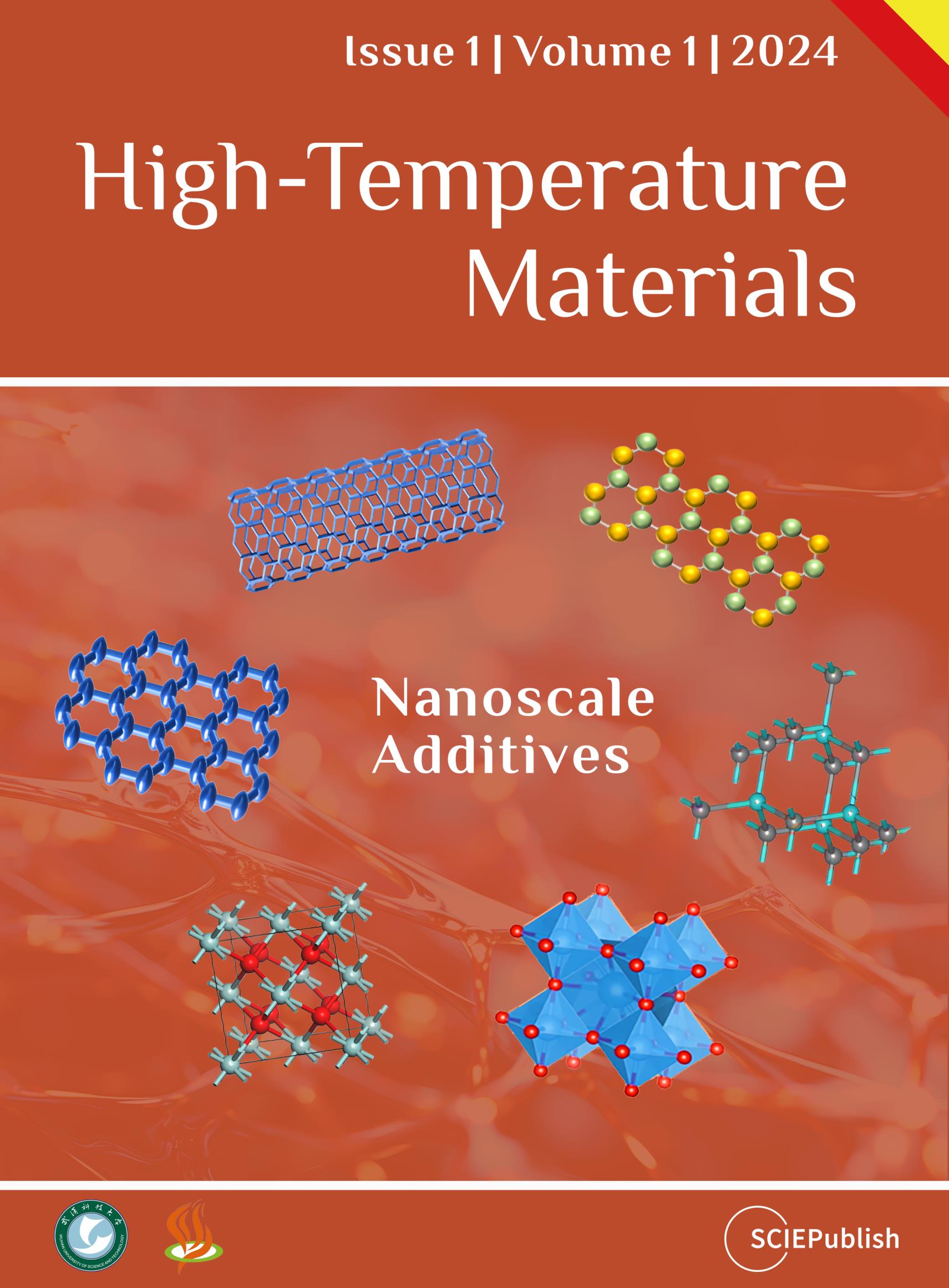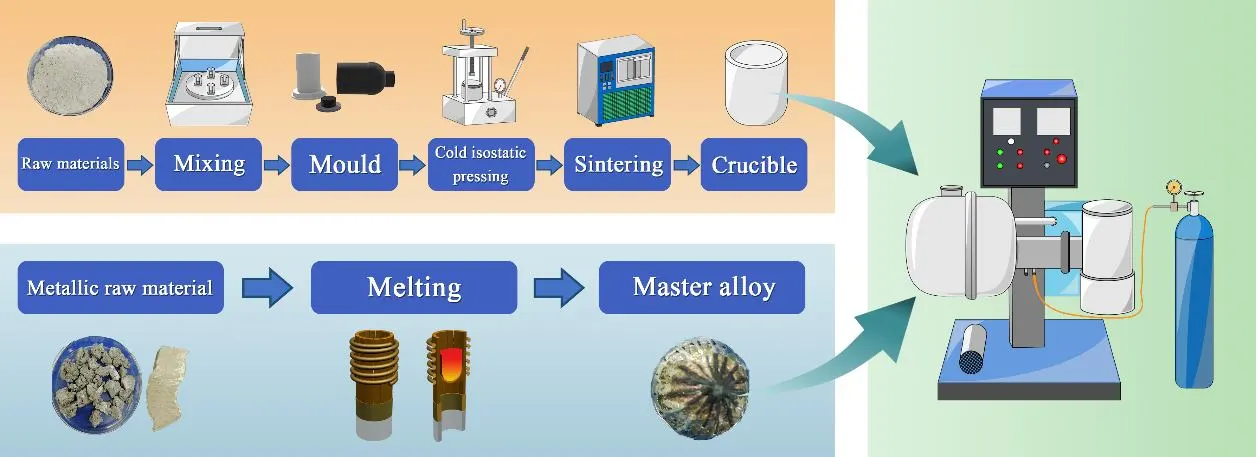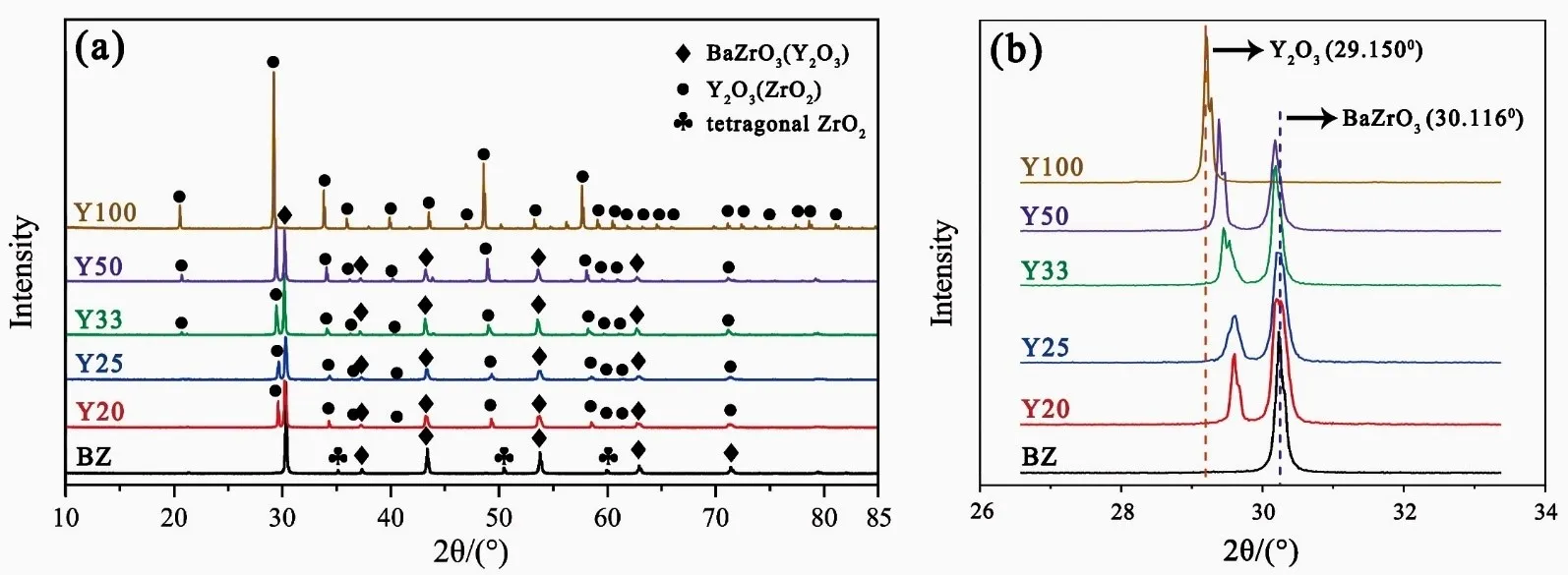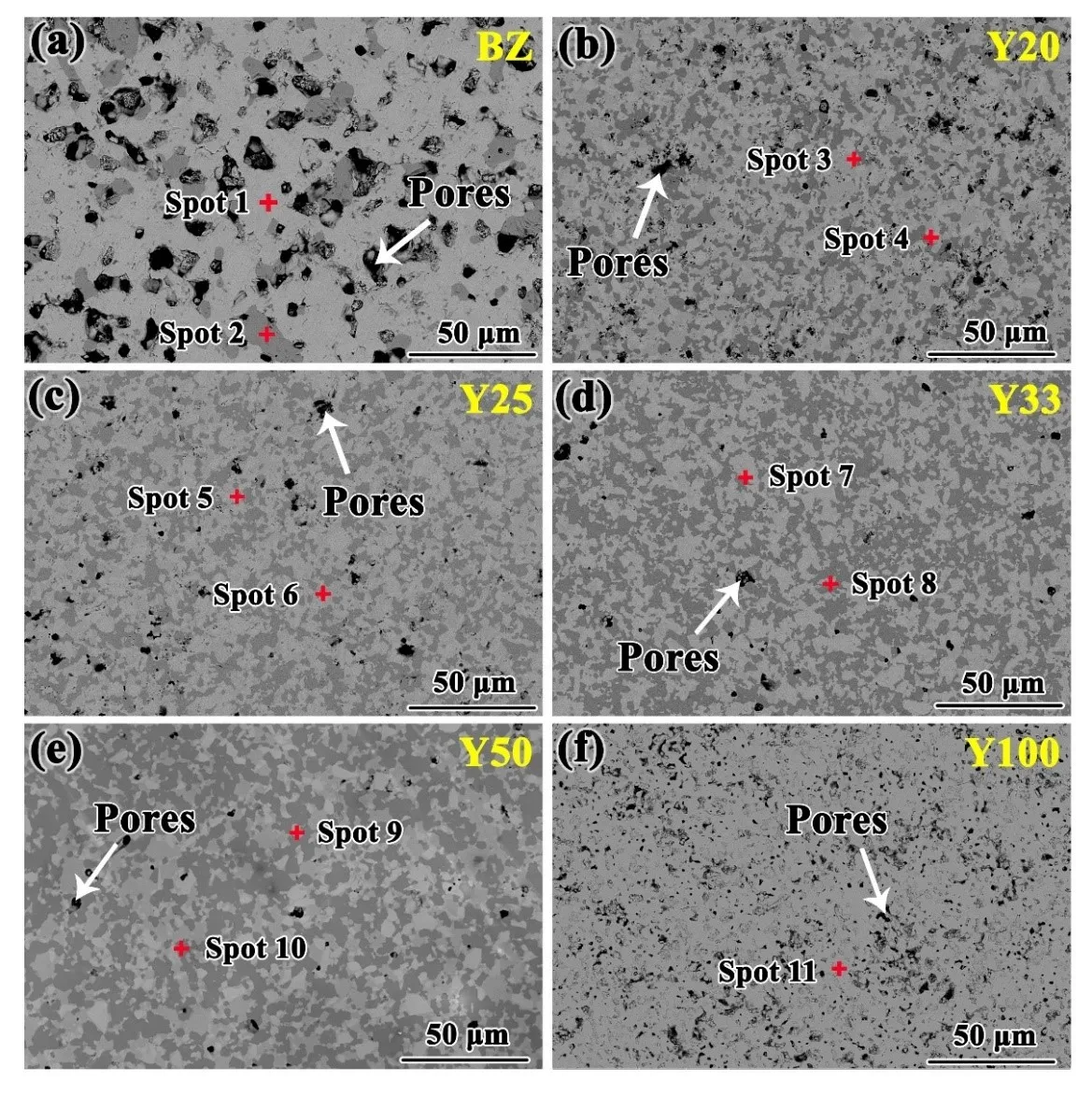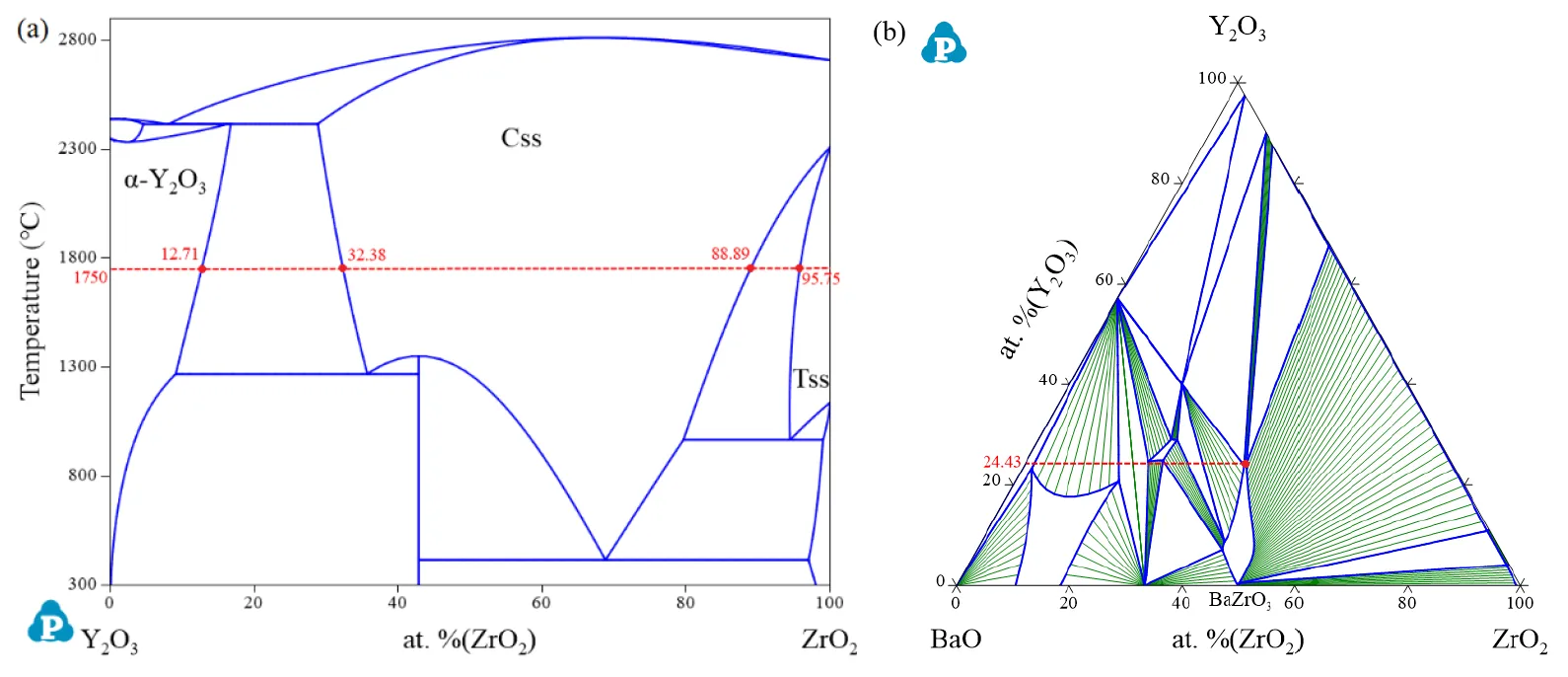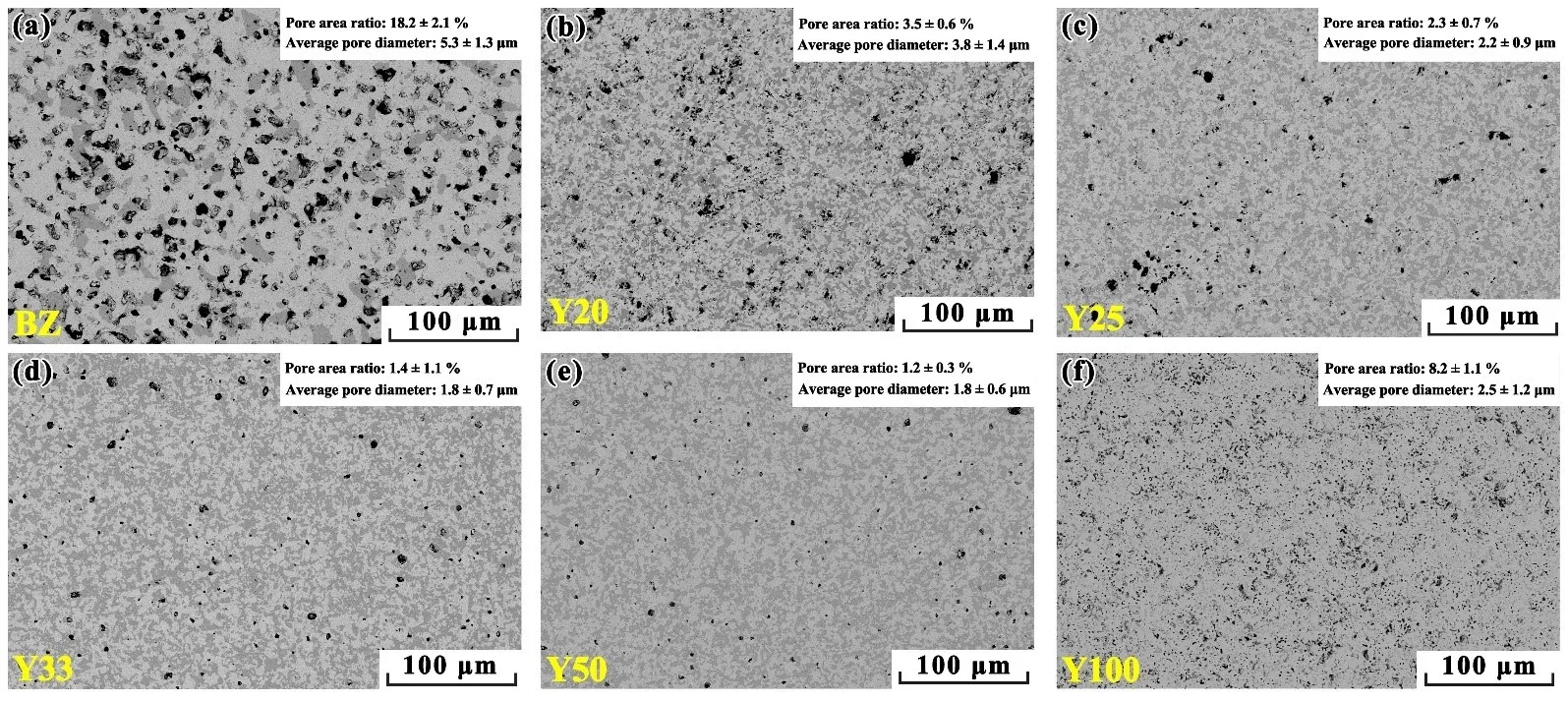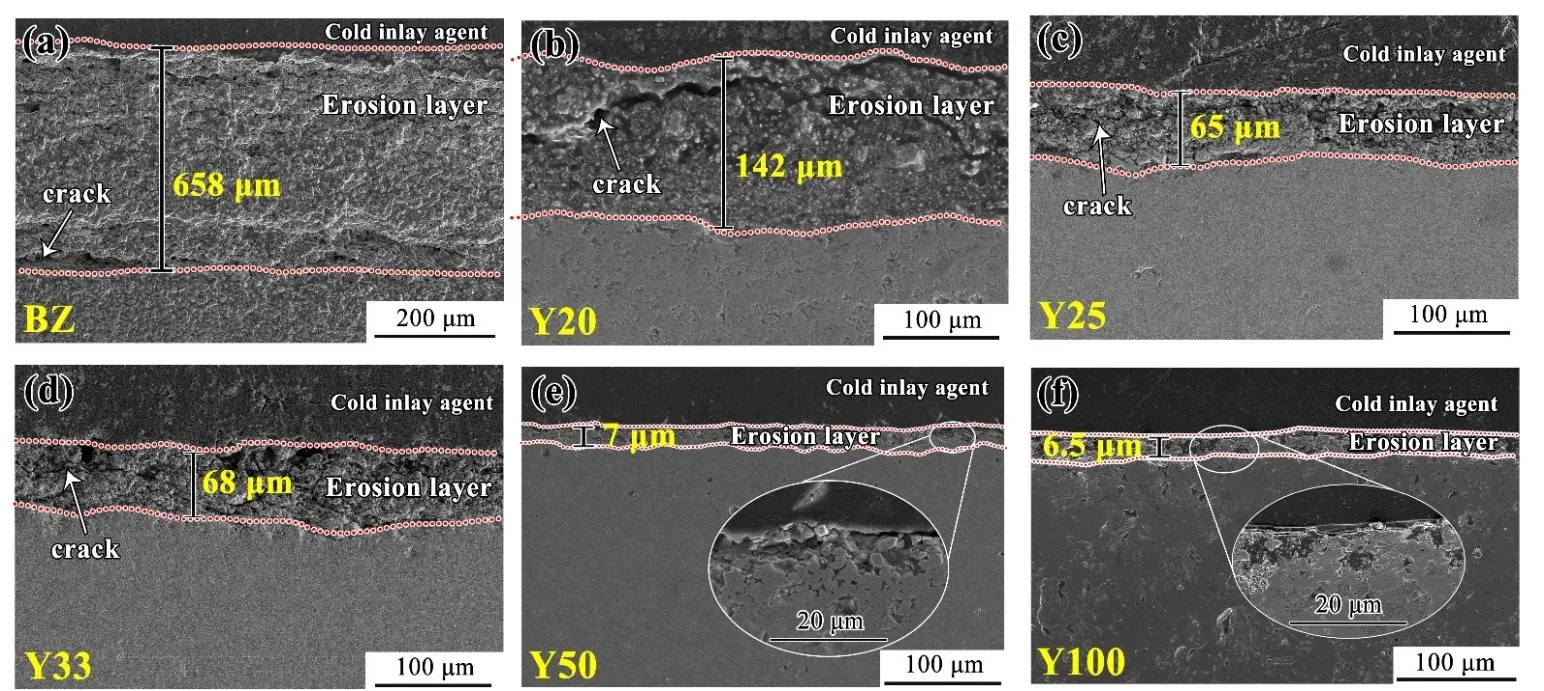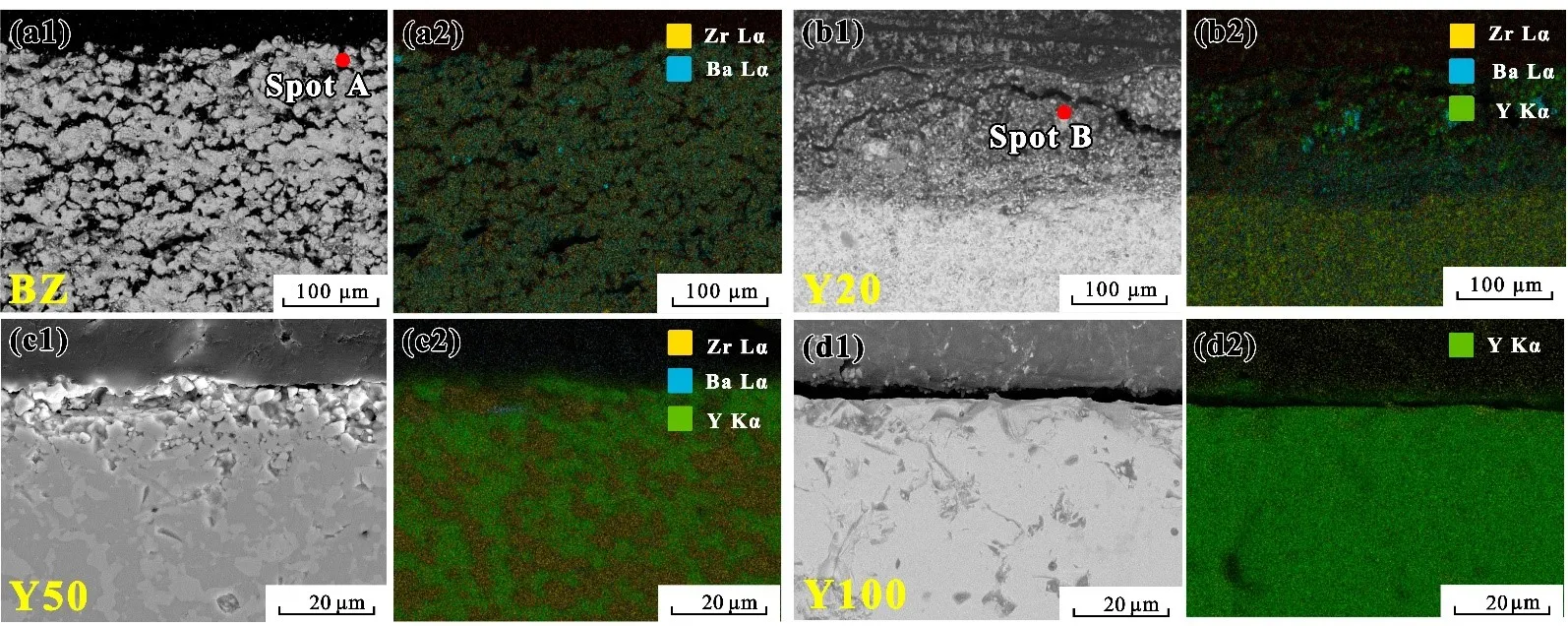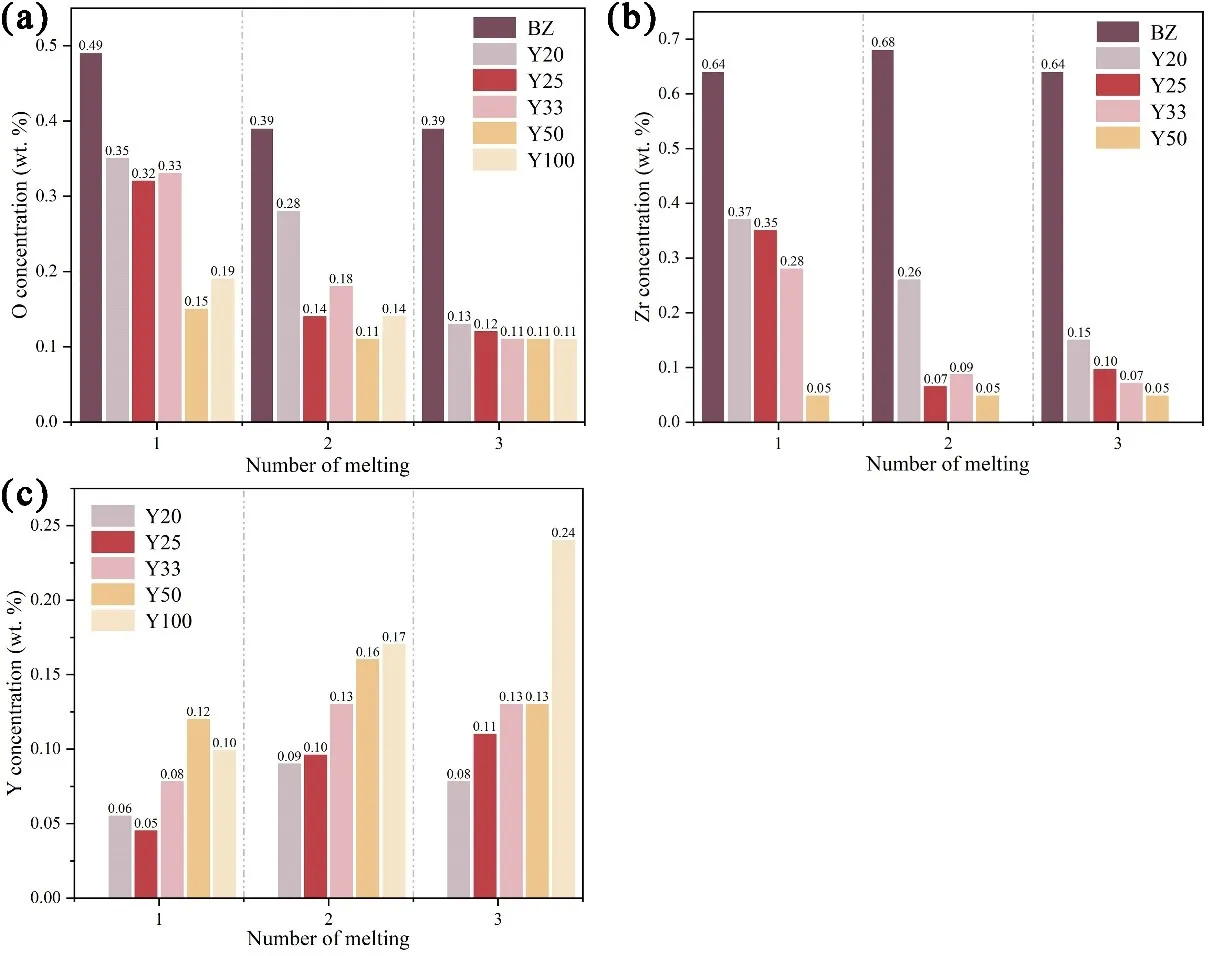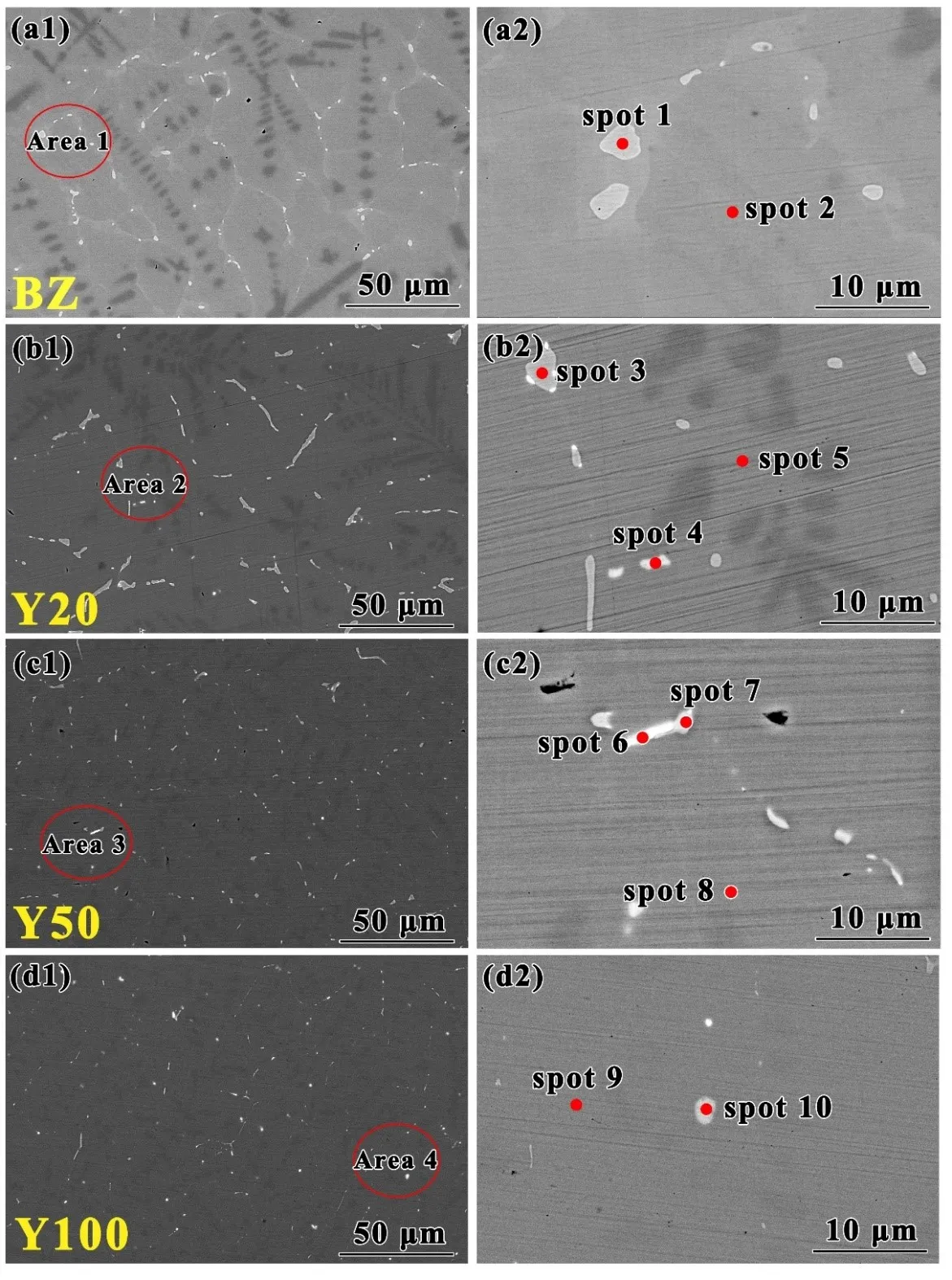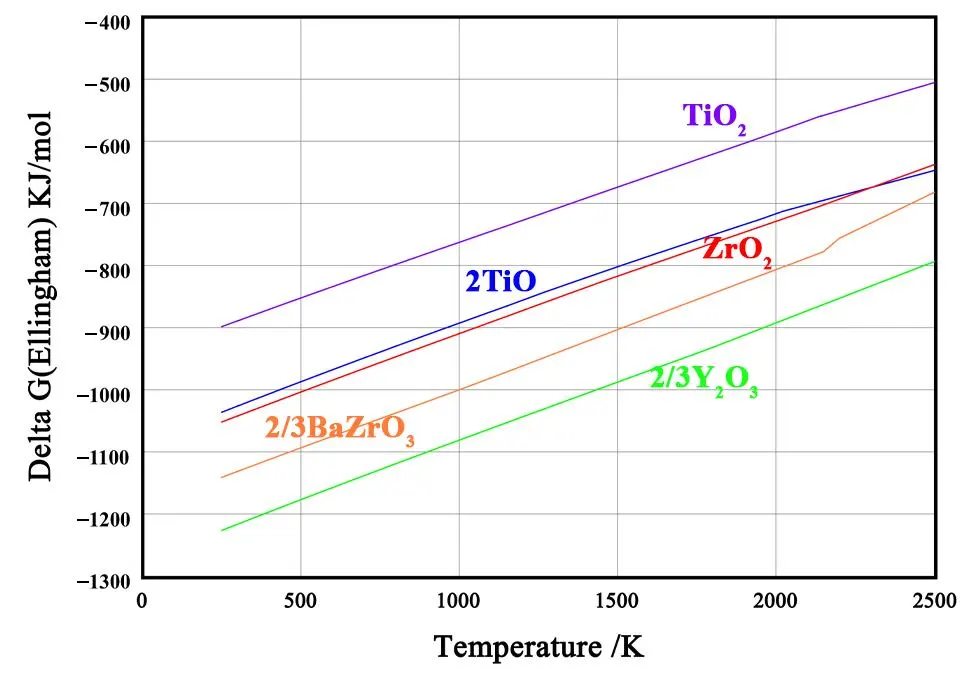Erosion Resistance of BaZrO3-Y2O3 Two-Phase Crucibles against Highly Active Ti2Ni Alloys
Qisheng Feng
1
Shaowen Deng
1
Houjin Liao
1
Chenxi Liu
1
Pengyue Gao
1,2
Enhui Wang
3
Xinmei Hou
3,*
Guangyao Chen
1,2,*
Chonghe Li
1,2,*
Author Information
Other Information
1
State Key Laboratory of Advanced Special Steel & Shanghai Key Laboratory of Advanced Ferrometallurgy & School of Materials Science and Engineering, Shanghai University, Shanghai 200072, China
2
Shanghai Special Casting Engineering Technology Research Center, Shanghai 201605, China
3
Institute for Carbon Neutrality, University of Science and Technology Beijing, Beijing 100083, China
*
Authors to whom correspondence should be addressed.
Received: 29 June 2024 Revised: 16 August 2024 Accepted: 19 August 2024 Published: 22 August 2024
© 2024 The authors. This is an open access article under the Creative Commons Attribution 4.0 International License (https://creativecommons.org/licenses/by/4.0/).
High-Temp. Mat.
2024,
1(1), 10003;
DOI: 10.35534/htm.2024.10003
ABSTRACT:
In this paper, (100-m) BaZrO3-mY2O3 (m = 0, 20, 25, 33, 50, 100) crucibles were
prepared, respectively. Then, the effect of crucible composition on the
interaction between crucibles and highly active titanium alloys (Ti2Ni) was investigated. The degree of the
erosion resistance of crucibles was compared
before and after melting as well as the contaminated extent of the alloys. The
results show that the two-phase crucibles consisting of BaZr1−xYxO3−δ and Y2O3(ZrO2), could be prepared
after adding Y2O3 into the BaZrO3 crucible. As the amount of Y2O3 addition in the crucible was increased, the
erosion resistance of the crucible
to the alloy melt was gradually improved. The two-phase crucible with 50 wt.%
Y2O3 addition exhibited
the best erosion resistance with a 7 μm thick erosion layer, which was at the
same level compared to the pure Y2O3 crucible (6.5 μm). However, the inclusion contaminants caused by this two-phase crucible were smaller than those of the pure Y2O3 crucible. This study provided a theoretical basis for further research
on the preparation of highly stable crucibles for melting highly active titanium
alloys.
Keywords:
BaZrO3; Y2O3; Crucible; Ti2Ni alloys; Vacuum
induction melting
1. Introduction
Titanium alloys have been extensively used in high-performance and advanced engineering fields like aerospace, marine, military and biomedical due to their excellent and well-balanced properties [1,2,3]. Additionally, the superior properties of the alloys in practical applications are often highly sensitive to their metallurgy quality.
Generally, Vacuum Arc Remelting (VAR), Plasma Arc Melting (PAM), Electron Beam Melting (EBM) and Induction Skull Melting (ISM) are commonly used to prepare the titanium alloys [4,5]. However, unavoidable heat loss and significant elemental segregation intensify the preparation cost due to forced water-cooling and repeated melting [5]. In contrast, Vacuum Induction Melting (VIM) in a refractory crucible has been considered low-cost for the one-time preparation of alloys. It is not only forced water-cooling that can be avoided, but also electromagnetic stirring that can achieve the rapid homogenization of alloy melts [6,7]. However, the highly reactive alloy melts will easily react with the refractory to contaminate the alloy melts. Thus, to select a highly stable crucible refractory is the key for the successful use of the VIM method [8].
Currently, the oxide refractories have been extensively investigated, including MgO, Al2O3, ZrO2, CaO, and Y2O3. However, these oxide refractory crucibles are proved to be somewhat problematic in the process of melting titanium alloys [9,10]. Among these refractories, only Y2O3 refractory has been successfully applied in the investment casting of titanium alloys. However, its application for melting titanium alloys still faces some technical problems due to poor thermal shock resistance [11,12]. Recently, the perovskite-structured refractory has attracted widespread attention due to the high thermodynamic stability and high melting points, such as CaZrO3, SrZrO3, and BaZrO3 [13,14,15,16]. Additionally, the BaZrO3 refractory has garnered significant attention in numerous studies for melting various types of titanium alloys. For example, Gao et al. prepared TiNi alloys in a BaZrO3 crucible, which achieved a higher shape memory rate and fatigue life than that prepared using a graphite crucible [17]. In addition, laboratory-grade TiAl alloys were prepared using the BaZrO3 crucible in comparison with the Al2O3 and MgO crucibles, respectively. It revealed that the BaZrO3 refractory caused the least contamination to the alloy melt [18]. Furthermore, a pilot-scale preparation of TiAl alloys was also achieved by using home-made 25 kg BaZrO3 crucible [19]. However, Chen et al. presented that the stability of the BaZrO3 crucible was insufficient during the melting of Ti-rich alloys [20]. Therefore, improving the stability of BaZrO3 crucibles is necessary to expand their application in the preparation of titanium alloys.
Researchers have reported that the stability of BaZrO3 refractory could be significantly improved by doping Y ions. Chen et al. compared the melting performance of BaZrO3 and Y-doped BaZrO3 crucibles in contact with the TixNi alloy melts, and confirmed that the Y-doped BaZrO3 refractory exhibited superior erosion resistance to the alloy melts [21]. Also, a similar experimental result was obtained by Kang’s study [22]. In addition, considering the high-temperature stability of Y2O3 refractory, and the Y-doped BaZrO3 solid solution phase, it could be generated by mixing and sintering the Y2O3 and BaZrO3 composite refractory. Chen et al. presented that the BaZrO3-Y2O3 two-phase refractory exhibited good stability. The performance for melting TiAl alloys had revealed that it had a better stability than that of the pure Y2O3 refractory [23]. However, due to the inadequacy of Ti activity in TiAl alloys, the advantage of the BaZrO3-Y2O3 two-phase crucible for melting Ti-rich alloys could not be fully reflected. Subsequently, Hou et al. [24] used the same BaZrO3-Y2O3 two-phase crucible for melting Ti2Ni alloy with higher Ti activity. The results preliminarily demonstrated that the BaZrO3-Y2O3 two-phase crucible exhibits better erosion resistance compared to the BaZrO3 crucible. However, the effects of different content of Y2O3 additions on the phase composition and microstructure of BaZrO3-Y2O3 two-phase crucible have not been investigated. The impact of Y2O3 addition on Ti2Ni alloy is also unknown, such as the content of inclusions. Therefore, it is necessary to further investigate the performance of BaZrO3-Y2O3 two-phase crucibles with different Y2O3 additions for melting Ti-rich alloys.
In this paper, the BaZrO3-Y2O3 two-phase crucibles with different content of Y2O3 additions were prepared, and their phase composition and microstructure were further investigated. The interaction of BaZrO3-Y2O3 two-phase crucibles with Ti-rich Ti2Ni alloys was studied in comparison with the pure BaZrO3 and Y2O3 crucibles. This study was devoted to obtaining high-quality Ti2Ni alloy ingot to lay the foundation for the preparation of A2B-type Ti2Ni hydrogen storage materials.
2. Experimental Procedure
2.1. Raw Materials
The crucible raw materials were BaZrO3 powder (purity > 99.9%, size 13 μm, Shandong Haoyao New Material Co., Ltd., Jinan, China) and commercial Y2O3 powder (purity > 99.9%, size 5 μm, Sinopharm Chemical Reagent Co., Ltd., Shanghai, China). The titanium sponge (purity > 99.9%) and nickel plate (purity > 99.9%) were used to prepare the Ti2Ni alloys.
2.2. Preparation of the Crucibles
Firstly, BaZrO3 and Y2O3 were mixed into four kinds of powders (Y20~Y50) according to different weight ratios, as shown in Table 1. These powders (Y20~Y50) were mixed with ethanol, respectively, and ball-milled in a concrete mixer at 300 rpm/min for 6 h, then dried at 120 °C for 12 h. The dried powders were fabricated into the crucible green body in a U-shape steel mandrel using the cold isostatic pressing with 150 MPa for 3 min, which was followed by sintering treatment at 1750 °C for 6 h in a silicon-molybdenum rod sintering furnace. Meanwhile, the BaZrO3 (BZ) and Y2O3 (Y100) crucibles were prepared in the same method. Before the melting, small pieces of the crucible were cut out and polished with ethanol in a metallographic polishing machine, which were used to analyze the microstructure.
2.3. Melting Experiment
A molar ratio of titanium sponge to nickel plate of 2:1 was adopted to prepare Ti2Ni master alloys in a water-cooled copper induction furnace. The crucible for melting was inserted into a VIM furnace (WZG-2, Jinzhou Oriental Metallurgical Technology Research Co., Ltd., Shenzhen, China) and filled with Al2O3 ramming mass to avoid the leakage of alloy melt. Then, 75 g Ti2Ni alloy was put in the crucible. The furnace was evacuated to 10−2 Pa and backfilled with high purity argon. The temperature was raised to 1600 °C holding for 3 min, and then it was poured into a graphite crucible to obtain alloy ingot. Three melts of Ti2Ni alloy were carried out using each crucible. The same melting process was performed for six different crucibles (BZ~Y100). The flowchart of the melting experiment was shown in Figure 1.
2.4. Analysis Method
For the crucibles before and after melting, the phase compositions were identified using X-ray diffraction (XRD, D8 Advance, Bruker, Ettlingen, Germany) with a Cu-Kα source operated at 40 KV and 30 mA (0.02 °, 4 °/min, variable slit). The microstructure of all samples was characterized by scanning electron microscopy (SEM, Gemini 300, Oberkochen, Germany) with energy dispersive spectroscopy (EDS, 50 mm2, X-Max N 50, Oxford, UK). The contamination of Ti2Ni alloy melts by crucibles was investigated using inductively coupled plasma atomic emission spectrometry (ICP-AES 710-ES, Palo Alto, CA, USA) and O/N/H analyzer (LECO TC600, St. Joseph, MI, USA).
Table 1. The crucible composition with different ratios of Y2O3 and BaZrO3 (wt.%).
Figure 1. Schematic diagram of the experimental procedure.
3. Results and Discussion
3.1. Phase and Microstructure Analysis of the Crucibles
Figure 2 shows the XRD patterns of BZ~Y100 crucibles after sintering. As can be seen in Figure 2a, the BZ crucible consisted of cubic BaZrO3 (ICDD PDF# 00-006-0399) and tetragonal ZrO2 (ICDD PDF# 00-080-2155) phases. Our previous study [23] revealed that the volatilization of BaO during the preparation of BaZrO3, resulted in the residual of the second phase ZrO2. When the adding amount of Y2O3 addition ranged from 20~50 wt.% (Y20~Y50), the ZrO2 phase disappeared. In addition, these crucibles consisted of BaZrO3 and cubic Y2O3 (ICDD PDF# 00-043-1036), respectively. From Figure 2b, it can be seen that the characteristic peaks of BaZrO3 and Y2O3 were shifted to lower and higher angles in the Y20~Y50 crucibles, respectively. It is because Zr4+ (0.72 Å) ions in BaZrO3 crystal lattice were partially replaced by Y3+ (0.90 Å) ions, and Y3+ ions in Y2O3 crystal lattice were partially substituted by Zr4+ ions, which could be further verified using the following formulae [25]:
where d is the interplanar spacing; λ is the X-ray wavelength; a is the lattice constant of the cubic structure; h, k and l are the Miller indices corresponding to the diffraction peak. Combining Equations (1) and (2) shows that the substitution of Y3+ ions for Zr4+ ions led to an increase in the lattice constant a, and an accompanying increase in the interplanar spacing d, which finally resulted in a decrease in θ, i.e., a leftward shift of diffraction peak. The space group of cubic BaZrO3 is Pm-3m, and Ba2+ ions with coordination number 12 and Zr4+ ions with coordination number 6 correspond to ionic radii of 1.61 Å and 0.72 Å, respectively [26]. The space group of cubic Y2O3 is Ia-3, and the ionic radius corresponding to Y3+ ions with coordination number 6 is 0.90 Å [26]. The relative ionic radius difference between Zr4+ and Y3+ ions is about 13%, which is less than 15%, indicating that they can be substituted for each other [27].
Figure 3 shows the inner microstructure of BZ~Y100 crucibles after grinding and polishing. From Figure 3a, it can be seen that the BZ crucible consisted of light gray (spot 1) and gray (spot 2) substances with the appearance of some pores, respectively. EDS results in Table 2 indicated that spots 1 and 2 were BaZrO3 and ZrO2 phases, respectively. After adding 20 wt.% Y2O3 into BaZrO3 (Y20 crucible, Figure 3b), the amount of gray substance (spot 4), which was dispersed throughout the crucible matrix, exhibited a significant increase trend and became Y2O3 with ZrO2 in solid solution. EDS results indicated spots 3 and 4 were BaZr1−xYxO3−δ and Y2O3(ZrO2), respectively. According to the phase diagram of ZrO2-Y2O3 system [28] shown in Figure 4a, at 1750 °C, the solubility limit of ZrO2 in cubic Y2O3 is 12.71 at. % (atomic percent) and the solubility limit of Y2O3 in tetragonal ZrO2 is 4.25 at. %. At the same time, the cubic solid solution formed by cubic ZrO2 and cubic Y2O3 ranges from 11.11 at. % to 67.62 at. %. The values of Y/(Zr + Y) (spots 4, 6, 8, and 10) in Table 2 are basically consistent with calculated results in Figure 4a. According to the isothermal section of the BaO-ZrO2-Y2O3 system [28] at 1750 °C (Figure 4b), the solubility limit of Y2O3 in BaZrO3 is 24.43 at. %. The values of Ba/(Zr + Y) and Y/(Zr + Y) (spots 3, 5, and 7) in Table 2 are fully consistent with calculated results in Figure 4b. For the EDS results of spot 9, the values of Ba/(Zr + Y) and Y/(Zr + Y) differ significantly from other results (spots 3, 5, and 7), which is considered to be due to measurement errors. It was caused by the solid solution of Y2O3 into BaZrO3 and ZrO2 into Y2O3, which was consistent with the shifts of observed characteristic peaks in Figure 2b. In addition, through comparison, it can be found that the number of pores in Figure 3b is significantly less than that in Figure 3a. Apparently, the Y2O3 addition had two obvious effects. One was to consume the ZrO2 phase in the crucible, leading to the formation of a more stable Y2O3(ZrO2) phase according to the solid solution effect [24]. The other was to increase the densification of the crucible due to the effect of solid solution sintering. As the amount of Y2O3 addition increased from 25~50 wt.% (Y25~Y50 crucibles), the different grains were evenly distributed, and the Y2O3(ZrO2) phase obviously increased with the growth of Y2O3 additions, as shown in Figure 3c–e. In addition, the number of pores in crucibles was further decreased, indicating that an increased amount of Y2O3 addition could continue to improve the densification of BaZrO3-Y2O3 two-phase crucibles. From Figure 3f, it can be seen that only Y2O3 phase (spot 11) could be observed, and a large number of pores were dispersed in the Y100 crucible. The solid solution between Y2O3, ZrO2 and BaZrO3 during sintering could be described as follows:
 To further investigate the effect of Y2O3 additions on the sintering behavior of BaZrO3-Y2O3 two-phase crucibles, ImageJ software was used to analyze the percentage of pore areas, as shown in Figure 5. Three pictures of each crucible sample were measured and the average percentage of pore areas was calculated. From Figure 5a, it can be seen that the percentage of pore areas in BZ crucible reached 18.2 ± 2.1%. It is because the BaZrO3 refractory with a high melting point (nearly 2650 °C) was difficult to densify at 1750 °C [23]. Additionally, the presence of ZrO2 secondary phase partially inhibited the growth of BaZrO3 grains, leading to the residual of pores. After adding Y2O3, from Figure 5b–e, it can be seen that the percentage of pore area in Y20~Y50 crucibles exhibited a significant decrease trend from 3.5 ± 0.6% to 1.2 ± 0.3%, respectively. The lower porosity could have a good effect to resist the erosion of alloy melts. In the BaO-Y2O3 phase diagram [28], all eutectic reaction temperatures including the liquid phase are greater than 1750 °C. When sintered at 1750 °C, Y3+ replaces Zr4+ in BaZrO3, resulting in oxygen vacancies [29]. These factors have led to the decrease in the percentage of pore area. For the Y100 crucible, its percentage of pore area also reached 8.2 ± 1.1%, as shown in Figure 5f. Apparently, the melting point of Y2O3 (2410 °C) [23] was lower than that of BaZrO3 (2650 °C), indicating that the sintering performance of Y2O3 was better than that of BaZrO3 under the same conditions.
3.2. Interaction between the Crucibles and Ti2Ni Alloy Melts
The phases of the inner surfaces of BZ~Y100 crucibles after the melting of Ti2Ni alloys were characterized by XRD, as shown in Figure 6. For the BZ crucible, not only no new phase was observed, but also the disappearance of ZrO2 characteristic peaks. The glassy phase is possible, but not easily detected by XRD, which is mainly sensitive to crystalline phases. Chen et al. [30] proposed that the interaction of refractory crucible with Ti melt was caused by physical dissolution of the refractory, it could be confirmed that the Ti2Ni alloy melt dissolved the ZrO2 refractory on the surface of the BaZrO3 crucible. The loose and non-uniform structure of the crucible surface is due to the partial dissolution of the BaZrO3 refractory. For the Y100 crucible, no new phase was observed compared to the original crucible in Figure 2a, indicating that the interaction of Ti2Ni alloy melt with Y2O3 crucible did not generate any new crystalline product but a glassy phase may exist. For the Y20~Y50 crucibles after melting, there was no appearance of new interaction product on their surfaces in comparison with the original crucibles in Figure 2a.
Figure 7 shows the cross-sections of the bottom wall of BZ~Y100 crucibles after melting Ti2Ni alloys. As shown in Figure 7a, the internal structure of the BZ crucible was damaged due to the infiltration of alloy melts. The generated thickness of the erosion layer was about 658 μm. For the Y20 crucible, the thickness of the erosion layer had a significant decrease to 142 μm, as shown in Figure 7b. As the increase of Y2O3 content in the BaZrO3 crucible, the thickness of the erosion layer was further decreased. For Y25~Y50 crucibles (Figure 7c–e), it ranged from 65 to 7 μm. However, for the Y100 crucible (Figure 7f), the thickness of the erosion layer was only 6.5 μm.
The magnified pictures of the erosion layers of BZ, Y20, Y50, and Y100 crucibles are shown in Figure 8. From Figure 8(a1), it can be seen that the erosion layer of BZ crucible exhibited a clear layered structure, which showed a loose and porous phenomenon. The corresponding mapping analysis indicated that only Ba and Zr elements exist in the erosion layer, and there is no residue of alloy melts, as shown in Figure 8(a2). In addition, the EDS result of spot A (Table 3) showed that BaO phase was observed. In our previous studies [23], we had revealed that the decomposition of BaZrO3 refractory in titanium alloy melts could cause the evaporation of BaO and the Zr and O elements into alloy melts. The same phenomenon was also observed in the melted Y20 crucible, as shown in Figure 8(b1,b2). In the Y50 crucible (Figure 8(c1,c2)), the enrichment of BaO disappeared as the decreasing of BaZrO3 content. In addition, the Zr elements caused by the dissolution of BaZrO3 would be partially dissolved into Y2O3, which will reduce the Zr pollution to the alloy. As can be seen from Figure 8(d1,d2), the Y100 crucible also did not react with alloy melt and was able to resist the mechanical scouring of alloy melt, indicating that Y2O3 refractory has good thermodynamic stability. However, the Y100 crucible has an obvious disadvantage, the Y generated by the dissolution of Y2O3 reacts with the O in the alloy melt to generate a large number of oxide inclusions [31].
Actually, the purity degree of titanium alloys was an important evaluation criterion for the practical application. Figure 9 shows the number of melted Ti2Ni alloys using BZ~Y100 crucibles as well as the O, Zr, and Y element concentrations in each alloy. Figure 9a shows the change trend of O concentration. It can be seen that the O concentration exhibited a decreasing trend as the increase of melting number regardless of the type of crucibles. However, it was more obvious that the BaZrO3 crucibles with Y2O3 addition exhibited a rapid decrease trend for the O concentration. It consisted of the analysis for the erosion layer in Figure 7 and Figure 8. Especially, the alloy melted in the Y50 crucible, its O concentration was only 0.11 wt.% after third melting, which is basically the same as that of alloy melted in the Y100 crucible. The change trend of Zr concentration is shown in Figure 9b, it can be seen that the Zr concentration also exhibited the same change trend as the O concentration. After third melting, the Zr concentration in alloy melted with the Y50 crucible was only 0.05 wt.%, which is much lower than 0.64 wt.% in the BZ crucible. This result was in consistent with the analysis of Figure 8, where the Zr element generated by the dissolution of crucibles was partially solidified into Y2O3. From Figure 9c, the Y concentration in alloy exhibited a clear increasing trend with the increase of Y2O3 addition. The Y concentration in alloy melted in the Y100 crucible increases from 0.10 to 0.24 wt.% with the increase in melting times, which is due to the large amount of Y2O3 dissolution [11,12]. After third melting, the Y concentration in alloy melted in Y20~Y50 crucibles ranged from 0.08 to 0.13 wt.%, and the Y50 crucible with the highest Y concentration was only half of the Y100 crucible. Considering the contamination degree from the three elements, the Y50 crucible clearly showed the best melting performance.
Figure 10 shows the microstructure of alloys for the third melting in BZ, Y20, Y50, and Y100 crucibles. From Figure 10(a1,a2), the alloy cooled in the BZ crucible contains some gray particles. Combined with EDS results in Table 4 (spots 1–2), the alloy matrix was Ti2Ni and the gray particles were residual TiNi. As can be seen in Figure 10(b1), some gray and white particles appeared in the alloy cooled in the Y20 crucible. The gray particles appeared as long strips with a tendency to break off, and most of white particles were attached around gray particles. Combined with the Figure 10(b2) and EDS results (spots 3–5) in Table 4, the white particles were Y2O3, the alloy matrix was Ti2Ni, which was consistent with the target composition, and the gray particles were residual TiNi. From the Ni-Ti phase diagram (Figure 11) [32], it can be seen that the Ti2Ni alloy firstly entered the two-phase region of liquid and TiNi from the liquid-phase region during solidification process, and then underwent the peritectic reaction Liquid + TiNi → Ti2Ni at 1258 K, and the generated Ti2Ni was retained until room temperature. It is hypothesized that the peritectic reaction did not occur completely resulting in a small amount of TiNi remaining in solidified Ti2Ni matrix. From Figure 10(c1,c2) and EDS results (spots 6–8) in Table 4, the same residual TiNi and inclusions Y2O3 were present in Ti2Ni matrix cooled in the Y50 crucible. As the Y2O3 content was increased, the residual long strips of TiNi became fewer and finer, while fracture occurred, indicating that Y2O3 promoted this peritectic reaction. The amount and morphology of TiNi remaining in the cooled Ti2Ni matrix in the Y100 crucible (Figure 10(d1,d2)) was basically the same as that of the Y50 crucible. The presence of Y2O3 inclusions was caused by the dissolution of Y2O3 refractory in melting process, which was facilitated by the Y100 crucible [33].
3.3. Erosion Resistance Mechanism
From the above analysis, it can be seen that BaZrO3-Y2O3 two-phase crucibles had a certain advantage in comparison with the pure BZ and Y100 crucibles. In particular, the Y50 crucible exhibited the best erosion resistance. In the following, the Y50 crucible was taken as an example to explore the mechanism by which it effectively prevents the erosion of alloy melts. With the addition of Y2O3, the average pore diameter of the crucible gradually decreases, and the Y50 crucible reaches the minimum value (1.8 ± 0.6 μm), as shown in Figure 5e. On the whole, combined with Figure 5 and Figure 7, the erosion layer thickness decreased with decreasing average pore diameter, which is consistent with the Washburn model for liquid penetration into a capillary [34]:
To further investigate the effect of Y2O3 additions on the sintering behavior of BaZrO3-Y2O3 two-phase crucibles, ImageJ software was used to analyze the percentage of pore areas, as shown in Figure 5. Three pictures of each crucible sample were measured and the average percentage of pore areas was calculated. From Figure 5a, it can be seen that the percentage of pore areas in BZ crucible reached 18.2 ± 2.1%. It is because the BaZrO3 refractory with a high melting point (nearly 2650 °C) was difficult to densify at 1750 °C [23]. Additionally, the presence of ZrO2 secondary phase partially inhibited the growth of BaZrO3 grains, leading to the residual of pores. After adding Y2O3, from Figure 5b–e, it can be seen that the percentage of pore area in Y20~Y50 crucibles exhibited a significant decrease trend from 3.5 ± 0.6% to 1.2 ± 0.3%, respectively. The lower porosity could have a good effect to resist the erosion of alloy melts. In the BaO-Y2O3 phase diagram [28], all eutectic reaction temperatures including the liquid phase are greater than 1750 °C. When sintered at 1750 °C, Y3+ replaces Zr4+ in BaZrO3, resulting in oxygen vacancies [29]. These factors have led to the decrease in the percentage of pore area. For the Y100 crucible, its percentage of pore area also reached 8.2 ± 1.1%, as shown in Figure 5f. Apparently, the melting point of Y2O3 (2410 °C) [23] was lower than that of BaZrO3 (2650 °C), indicating that the sintering performance of Y2O3 was better than that of BaZrO3 under the same conditions.
3.2. Interaction between the Crucibles and Ti2Ni Alloy Melts
The phases of the inner surfaces of BZ~Y100 crucibles after the melting of Ti2Ni alloys were characterized by XRD, as shown in Figure 6. For the BZ crucible, not only no new phase was observed, but also the disappearance of ZrO2 characteristic peaks. The glassy phase is possible, but not easily detected by XRD, which is mainly sensitive to crystalline phases. Chen et al. [30] proposed that the interaction of refractory crucible with Ti melt was caused by physical dissolution of the refractory, it could be confirmed that the Ti2Ni alloy melt dissolved the ZrO2 refractory on the surface of the BaZrO3 crucible. The loose and non-uniform structure of the crucible surface is due to the partial dissolution of the BaZrO3 refractory. For the Y100 crucible, no new phase was observed compared to the original crucible in Figure 2a, indicating that the interaction of Ti2Ni alloy melt with Y2O3 crucible did not generate any new crystalline product but a glassy phase may exist. For the Y20~Y50 crucibles after melting, there was no appearance of new interaction product on their surfaces in comparison with the original crucibles in Figure 2a.
Figure 7 shows the cross-sections of the bottom wall of BZ~Y100 crucibles after melting Ti2Ni alloys. As shown in Figure 7a, the internal structure of the BZ crucible was damaged due to the infiltration of alloy melts. The generated thickness of the erosion layer was about 658 μm. For the Y20 crucible, the thickness of the erosion layer had a significant decrease to 142 μm, as shown in Figure 7b. As the increase of Y2O3 content in the BaZrO3 crucible, the thickness of the erosion layer was further decreased. For Y25~Y50 crucibles (Figure 7c–e), it ranged from 65 to 7 μm. However, for the Y100 crucible (Figure 7f), the thickness of the erosion layer was only 6.5 μm.
The magnified pictures of the erosion layers of BZ, Y20, Y50, and Y100 crucibles are shown in Figure 8. From Figure 8(a1), it can be seen that the erosion layer of BZ crucible exhibited a clear layered structure, which showed a loose and porous phenomenon. The corresponding mapping analysis indicated that only Ba and Zr elements exist in the erosion layer, and there is no residue of alloy melts, as shown in Figure 8(a2). In addition, the EDS result of spot A (Table 3) showed that BaO phase was observed. In our previous studies [23], we had revealed that the decomposition of BaZrO3 refractory in titanium alloy melts could cause the evaporation of BaO and the Zr and O elements into alloy melts. The same phenomenon was also observed in the melted Y20 crucible, as shown in Figure 8(b1,b2). In the Y50 crucible (Figure 8(c1,c2)), the enrichment of BaO disappeared as the decreasing of BaZrO3 content. In addition, the Zr elements caused by the dissolution of BaZrO3 would be partially dissolved into Y2O3, which will reduce the Zr pollution to the alloy. As can be seen from Figure 8(d1,d2), the Y100 crucible also did not react with alloy melt and was able to resist the mechanical scouring of alloy melt, indicating that Y2O3 refractory has good thermodynamic stability. However, the Y100 crucible has an obvious disadvantage, the Y generated by the dissolution of Y2O3 reacts with the O in the alloy melt to generate a large number of oxide inclusions [31].
Actually, the purity degree of titanium alloys was an important evaluation criterion for the practical application. Figure 9 shows the number of melted Ti2Ni alloys using BZ~Y100 crucibles as well as the O, Zr, and Y element concentrations in each alloy. Figure 9a shows the change trend of O concentration. It can be seen that the O concentration exhibited a decreasing trend as the increase of melting number regardless of the type of crucibles. However, it was more obvious that the BaZrO3 crucibles with Y2O3 addition exhibited a rapid decrease trend for the O concentration. It consisted of the analysis for the erosion layer in Figure 7 and Figure 8. Especially, the alloy melted in the Y50 crucible, its O concentration was only 0.11 wt.% after third melting, which is basically the same as that of alloy melted in the Y100 crucible. The change trend of Zr concentration is shown in Figure 9b, it can be seen that the Zr concentration also exhibited the same change trend as the O concentration. After third melting, the Zr concentration in alloy melted with the Y50 crucible was only 0.05 wt.%, which is much lower than 0.64 wt.% in the BZ crucible. This result was in consistent with the analysis of Figure 8, where the Zr element generated by the dissolution of crucibles was partially solidified into Y2O3. From Figure 9c, the Y concentration in alloy exhibited a clear increasing trend with the increase of Y2O3 addition. The Y concentration in alloy melted in the Y100 crucible increases from 0.10 to 0.24 wt.% with the increase in melting times, which is due to the large amount of Y2O3 dissolution [11,12]. After third melting, the Y concentration in alloy melted in Y20~Y50 crucibles ranged from 0.08 to 0.13 wt.%, and the Y50 crucible with the highest Y concentration was only half of the Y100 crucible. Considering the contamination degree from the three elements, the Y50 crucible clearly showed the best melting performance.
Figure 10 shows the microstructure of alloys for the third melting in BZ, Y20, Y50, and Y100 crucibles. From Figure 10(a1,a2), the alloy cooled in the BZ crucible contains some gray particles. Combined with EDS results in Table 4 (spots 1–2), the alloy matrix was Ti2Ni and the gray particles were residual TiNi. As can be seen in Figure 10(b1), some gray and white particles appeared in the alloy cooled in the Y20 crucible. The gray particles appeared as long strips with a tendency to break off, and most of white particles were attached around gray particles. Combined with the Figure 10(b2) and EDS results (spots 3–5) in Table 4, the white particles were Y2O3, the alloy matrix was Ti2Ni, which was consistent with the target composition, and the gray particles were residual TiNi. From the Ni-Ti phase diagram (Figure 11) [32], it can be seen that the Ti2Ni alloy firstly entered the two-phase region of liquid and TiNi from the liquid-phase region during solidification process, and then underwent the peritectic reaction Liquid + TiNi → Ti2Ni at 1258 K, and the generated Ti2Ni was retained until room temperature. It is hypothesized that the peritectic reaction did not occur completely resulting in a small amount of TiNi remaining in solidified Ti2Ni matrix. From Figure 10(c1,c2) and EDS results (spots 6–8) in Table 4, the same residual TiNi and inclusions Y2O3 were present in Ti2Ni matrix cooled in the Y50 crucible. As the Y2O3 content was increased, the residual long strips of TiNi became fewer and finer, while fracture occurred, indicating that Y2O3 promoted this peritectic reaction. The amount and morphology of TiNi remaining in the cooled Ti2Ni matrix in the Y100 crucible (Figure 10(d1,d2)) was basically the same as that of the Y50 crucible. The presence of Y2O3 inclusions was caused by the dissolution of Y2O3 refractory in melting process, which was facilitated by the Y100 crucible [33].
3.3. Erosion Resistance Mechanism
From the above analysis, it can be seen that BaZrO3-Y2O3 two-phase crucibles had a certain advantage in comparison with the pure BZ and Y100 crucibles. In particular, the Y50 crucible exhibited the best erosion resistance. In the following, the Y50 crucible was taken as an example to explore the mechanism by which it effectively prevents the erosion of alloy melts. With the addition of Y2O3, the average pore diameter of the crucible gradually decreases, and the Y50 crucible reaches the minimum value (1.8 ± 0.6 μm), as shown in Figure 5e. On the whole, combined with Figure 5 and Figure 7, the erosion layer thickness decreased with decreasing average pore diameter, which is consistent with the Washburn model for liquid penetration into a capillary [34]:
 where h is the erosion layer thickness, r is the pore radius, θ is the contact angle, σ is the surface tension, t is the interaction time, and η is the alloy melt viscosity. Although the porosity also decreases with the addition of Y2O3, the Y50 crucible also reaches the minimum value (1.2 ± 0.3%), the erosion layer thickness of the Y100 crucible with a porosity of 8.2 ± 1.1% is basically the same as that of the Y50 crucible. This showed that the average pore size has more influence on the erosion layer than porosity.
The erosion resistance of crucible was also affected by its thermodynamic stability and thermal shock resistance [9,35]. Figure 12 shows the Ellingham diagram of TiO2, TiO, ZrO2, BaZrO3 and Y2O3. At the experimental temperature (1600 °C), the thermodynamic stability of ZrO2, BaZrO3 and Y2O3 was significantly higher than that of TiO2 and TiO. Therefore, no chemical reaction occurred between BZ~Y100 crucibles and alloy melts, which was consistent with the experimental results. In BaZrO3-Y2O3 two-phase crucibles, the presence of solid solution effects led to a further decrease in the Gibbs free energy of BaZr1−xYxO3−δ and Y2O3(ZrO2) [23]. Hence, compared to BZ and Y100 crucibles, the Y50 crucible had a higher thermodynamic stability. It should be noted that physical dissolution of crucible refractory was unavoidable due to mechanical scouring of the inner wall of crucible by alloy melts [36].
Generally, crucibles with low porosity and high thermal shock resistance would have a long service life. In addition, high thermal conductivity and a low linear expansion coefficient were necessary to obtain high thermal shock resistance [37]. High thermal conductivity crucibles had smaller thermal gradients, while low linear expansion coefficient crucibles expanded less and deformed more uniformly, thus reducing thermal stresses and preventing the damage of the crucible. The thermal shock resistance of crucibles could be predicted by calculating the thermal stress resistance parameters R, the following equations [38,39]:
where h is the erosion layer thickness, r is the pore radius, θ is the contact angle, σ is the surface tension, t is the interaction time, and η is the alloy melt viscosity. Although the porosity also decreases with the addition of Y2O3, the Y50 crucible also reaches the minimum value (1.2 ± 0.3%), the erosion layer thickness of the Y100 crucible with a porosity of 8.2 ± 1.1% is basically the same as that of the Y50 crucible. This showed that the average pore size has more influence on the erosion layer than porosity.
The erosion resistance of crucible was also affected by its thermodynamic stability and thermal shock resistance [9,35]. Figure 12 shows the Ellingham diagram of TiO2, TiO, ZrO2, BaZrO3 and Y2O3. At the experimental temperature (1600 °C), the thermodynamic stability of ZrO2, BaZrO3 and Y2O3 was significantly higher than that of TiO2 and TiO. Therefore, no chemical reaction occurred between BZ~Y100 crucibles and alloy melts, which was consistent with the experimental results. In BaZrO3-Y2O3 two-phase crucibles, the presence of solid solution effects led to a further decrease in the Gibbs free energy of BaZr1−xYxO3−δ and Y2O3(ZrO2) [23]. Hence, compared to BZ and Y100 crucibles, the Y50 crucible had a higher thermodynamic stability. It should be noted that physical dissolution of crucible refractory was unavoidable due to mechanical scouring of the inner wall of crucible by alloy melts [36].
Generally, crucibles with low porosity and high thermal shock resistance would have a long service life. In addition, high thermal conductivity and a low linear expansion coefficient were necessary to obtain high thermal shock resistance [37]. High thermal conductivity crucibles had smaller thermal gradients, while low linear expansion coefficient crucibles expanded less and deformed more uniformly, thus reducing thermal stresses and preventing the damage of the crucible. The thermal shock resistance of crucibles could be predicted by calculating the thermal stress resistance parameters R, the following equations [38,39]:
 where σf, E, α, and ν represent the strength, Young’s modulus, coefficient of linear expansion and Poisson’s ratio, respectively. R represents the maximum allowable temperature difference. These parameters could be used to evaluate the cracking sensitivity of crucibles after erosion of molten alloys. Table 5 lists the calculated R values of BaZrO3 and Y2O3. All data in Table 5 are derived from Ref. [9]. The σf value is cold modulus of rupture value. The α value ranges from room temperature to 1200 °C. It can be seen that BaZrO3 and Y2O3 possessed similar intrinsic physical properties such as strength, Young’s modulus, coefficient of linear expansion and Poisson’s ratio. Therefore, for the Y50 crucible, using the mixing rule, BaZrO3 and Y2O3 were more easily combined with each other. The similar maximum allowable temperature difference (R) ensured that no cracks occurred between BaZrO3 and Y2O3 in the melting process of the Y50 crucible, thus showing a good thermal shock resistance. In conclusion, the excellent thermodynamic stability and thermal shock resistance of the Y50 crucible made it a promising application in VIM of highly reactive titanium alloys.
where σf, E, α, and ν represent the strength, Young’s modulus, coefficient of linear expansion and Poisson’s ratio, respectively. R represents the maximum allowable temperature difference. These parameters could be used to evaluate the cracking sensitivity of crucibles after erosion of molten alloys. Table 5 lists the calculated R values of BaZrO3 and Y2O3. All data in Table 5 are derived from Ref. [9]. The σf value is cold modulus of rupture value. The α value ranges from room temperature to 1200 °C. It can be seen that BaZrO3 and Y2O3 possessed similar intrinsic physical properties such as strength, Young’s modulus, coefficient of linear expansion and Poisson’s ratio. Therefore, for the Y50 crucible, using the mixing rule, BaZrO3 and Y2O3 were more easily combined with each other. The similar maximum allowable temperature difference (R) ensured that no cracks occurred between BaZrO3 and Y2O3 in the melting process of the Y50 crucible, thus showing a good thermal shock resistance. In conclusion, the excellent thermodynamic stability and thermal shock resistance of the Y50 crucible made it a promising application in VIM of highly reactive titanium alloys.
```latex2d\sin\theta=n\lambda(n=1,2,3\cdots)```
```latexd=a/\sqrt{(h^2+k^2+l^2)}```
Figure 2. (<b>a</b>) XRD patterns of all crucibles after sintering; (<b>b</b>) magnified pictures over the 2<i>θ</i> ranges of 28~32° showing Y<sub>2</sub>O<sub>3</sub> and BaZrO<sub>3</sub> peaks.

```latex\mathrm{Y_2O_3+ZrO_2\xrightarrow{1750°C,6~h}Y_2O_3(ZrO_2)}```
Figure 3. SEM pictures (BSE mode) of bottom wall of all crucibles after grinding and polishing: (<b>a</b>) BZ crucible; (<b>b</b>) Y20 crucible; (<b>c</b>) Y25 crucible; (<b>d</b>) Y33 crucible; (<b>e</b>) Y50 crucible; (<b>f</b>) Y100 crucible.
Figure 4. (<b>a</b>) Calculated phase diagram of ZrO<sub>2</sub>-Y<sub>2</sub>O<sub>3</sub> system (Css---Cubic structure solid solution; Tss---Tetragonal structure solid solution) [28]; (<b>b</b>) Calculated isothermal section of BaO-ZrO<sub>2</sub>-Y<sub>2</sub>O<sub>3</sub> system at 1750 °C [28].
Figure 5. SEM pictures of the inner of all crucibles and the measured porosity ratio: (<b>a</b>) BZ crucible; (<b>b</b>) Y20 crucible; (<b>c</b>) Y25 crucible; (<b>d</b>) Y33 crucible; (<b>e</b>) Y50 crucible; (<b>f</b>) Y100 crucible.
Figure 6. XRD patterns of the inner surface of all crucibles after the melting of Ti<sub>2</sub>Ni alloys.
Figure 7. SEM pictures of the cross-section of bottom wall of all crucibles after melting Ti<sub>2</sub>Ni alloys: (<b>a</b>) BZ crucible; (<b>b</b>) Y20 crucible; (<b>c</b>) Y25 crucible; (<b>d</b>) Y33 crucible; (<b>e</b>) Y50 crucible; (<b>f</b>) Y100 crucible.
Figure 8. Localized enlargement of the erosion layers of crucibles: (<b>a1</b>) BZ crucible; (<b>a2</b>) the elemental mapping of Figure 8(a1); (<b>b1</b>) Y20 crucible; (<b>b2</b>) the elemental mapping of Figure 8(b1); (<b>c1</b>) Y50 crucible; (<b>c2</b>) the elemental mapping of Figure 8(c1); (<b>d1</b>) Y100 crucible; (<b>d2</b>) the elemental mapping of Figure 8(d1).
Figure 9. The O, Zr, and Y element concentrations in Ti<sub>2</sub>Ni alloys after melting for different times using the BZ~Y100 crucibles: (<b>a</b>) O concentration; (<b>b</b>) Zr concentration; (<b>c</b>) Y concentration.
Figure 10. SEM photographs of the alloys melted in crucibles for the third melting: (<b>a1</b>) in the BZ crucible; (<b>a2</b>) the magnified image of area 1; (<b>b1</b>) in the Y20 crucible; (<b>b2</b>) the magnified image of area 2; (<b>c1</b>) in the Y50 crucible; (<b>c2</b>) the magnified image of area 3; (<b>d1</b>) in the Y100 crucible; (<b>d2</b>) the magnified image of area 4.

Figure 12. Gibbs free energy of formation of TiO<sub>2</sub>, TiO, ZrO<sub>2</sub>, BaZrO<sub>3</sub> and Y<sub>2</sub>O<sub>3</sub>.

Table 5. Calculated R values of BaZrO3 and Y2O3.
4. Conclusions
In this paper, the BaZrO3-Y2O3 two-phase crucibles were prepared, and their performance for melting Ti2Ni alloys was evaluated by comparing with the pure BaZrO3 and Y2O3 crucibles, respectively. The main conclusions were summarized as follows:
(1) After sintering, the BaZrO3-Y2O3 two-phase crucibles consisted of BaZr1−xYxO3−δ and Y2O3(ZrO2) phases due to the mutual substitution of Zr4+ and Y3+ ions. The density of two-phase crucibles was significantly increased with the increase of Y2O3 addition. When Y2O3 addition reached 50 wt.%, the Y50 crucible had the highest densification, and its porosity was only 1.2 ± 0.3%.
(2) After melting Ti2Ni alloys, the Y50 crucible exhibited the best erosion resistance to alloy melt with a 7 μm thick erosion layer. In addition, this crucible could introduce the least element and inclusion contamination to alloy melts. The concentration of O, Zr, and Y elements in alloys was 0.11, 0.05 and 0.13 wt.% after third melting, respectively. This crucible had better thermodynamic stability and thermal shock resistance, indicating that it was a promising candidate for the achievement of VIM of highly reactive titanium alloys.
Acknowledgments
This work was supported by the National Key Research and Development Program (2022YFB3404500), National Natural Science Foundation of China (No. 52104305, 12305374, 52374360 and U2341267). Additionally, we thank the anonymous referee of this paper for their constructive suggestions.
Author Contributions
Conceptualization, C.L. (Chonghe Li) and G.C.; Methodology, P.G.; Software, Q.F.; Validation, P.G.; Formal Analysis, E.W.; Investigation, Q.F. and S.D.; Resources, G.C. and H.L.; Data Curation, S.D. and C.L. (Chenxi Liu); Writing—Original Draft Preparation, Q.F.; Writing—Review & Editing, C.L. (Chonghe Li), X.H. and G.C.; Visualization, H.L.; Supervision, E.W.; Project Administration, C.L. (Chonghe Li) and G.C.; Funding Acquisition, C.L. (Chonghe Li) and X.H.
Ethics Statement
Not applicable.
Informed Consent Statement
Not applicable.
Funding
This research received no external funding.
Declaration of Competing Interest
The authors declare that they have no known competing financial interests or personal relationships that could have appeared to influence the work reported in this paper.
References
1.
Zhao QY, Sun QY, Xin SW, Chen YN, Wu C, Wang H, et al. High-strength titanium alloys for aerospace engineering applications: A review on melting-forging process. J. Mater. Sci. Eng. A 2022, 845, 143260. [Google Scholar]
2.
Feng QS, Lv MR, Mao L, Duan BB, Yang YC, Chen GY, et al. Research progress of titanium sponge production: A review. Metals 2023, 13, 408. [Google Scholar]
3.
Zhang LC, Chen LY. A review on biomedical titanium alloys: Recent progress and prospect. Adv. Eng. Mater. 2019, 21, 1801215. [Google Scholar]
4.
Cui CX, Hu BM, Zhao LC, Liu SJ. Titanium alloy production technology, market prospects and industry development. Mater. Des. 2011, 32, 1684–1691. [Google Scholar]
5.
Guther V, Allen M, Klose J, Clemens H. Metallurgical processing of titanium aluminides on industrial scale. Intermetallics 2018, 103, 12–22. [Google Scholar]
6.
Barbosa J, Ribeiro CS, Monteiro AC. Influence of superheating on casting of γ-TiAl. Intermetallics 2007, 15, 945–955. [Google Scholar]
7.
Sung SY, Kim YJ. Economic net-shape forming of TiAl alloys for automotive parts. Intermetallics 2006, 14, 1163–1167. [Google Scholar]
8.
Weber BC, Thompson WM, Bielstein HO, Schwartz MA. Ceramic crucible for melting titanium. J. Am. Ceram. Soc. 1957, 40, 363–373. [Google Scholar]
9.
Wang RY, Zhao C, Liu XT, Sun MH, Li N. Anti-corrosion AlN ceramic crucible with excellent thermal shock resistance for induction melting of TiAl alloy. Ceram. Int. 2023, 49, 35679–35686. [Google Scholar]
10.
Cui RJ, Tang XX, Gao M, Zhang H, Gong SK. Thermodynamic analysis of interactions between Ti-Al alloys and oxide ceramics. Trans. Nonferrous Met. Soc. China 2012, 22, 887–894. [Google Scholar]
11.
Ren P, Wang XG, Zhang M, Sun XD. Fabrication of yttrium oxide refractory with high strength and thermal shock stability for smelting TiAl alloy. Ceram. Int. 2024, 50, 464–473. [Google Scholar]
12.
Li HR, Liu Y, Yang JJ, Yuan M, Sun AL, Lin TS, et al. Preparation and application evaluation of La2O3-doped Y2O3 crucible materials for melting TiAl alloys. Ceram. Int. 2022, 48, 15762–15769. [Google Scholar]
13.
Schaffoner S, Aneziris CG, Berek H, Rotmann B, Friedrich B. Investigating the corrosion resistance of calcium zirconate in contact with titanium alloy melts. J. Eur. Ceram. Soc. 2015, 35, 259–266. [Google Scholar]
14.
Li ZY, Fu L, Zou YS, Gu HZ, Huang A, Chen D, et al. A novel potential ceramic material for melting Ti6Al4V alloy: A solid solution of BaZrO3 and CaZrO3. J. Eur. Ceram. Soc. 2023, 43, 6571–6580. [Google Scholar]
15.
Meng DZ, Chen GY, Zhang RL, Li CH. Preparation of Y2O3 doped SrZrO3 refractory and study on its interface reaction with molten TiNi alloys. Key Eng. Mater. 2018, 768, 256–260. [Google Scholar]
16.
Qiu SH, Li ML, Shao G, Wang HL, Zhu JP, Liu W, et al. (Ca,Sr,Ba)ZrO3: A promising entropy-stabilized ceramic for titanium alloys smelting. J. Mater. Sci. Technol. 2021, 65, 82–88. [Google Scholar]
17.
Gao PY, Liu YZ, Ren Y, Chen GY, Lan BB, Lu XG, et al. Evaluation of the microstructure and property of TiNi SMA prepared using VIM in BaZrO3 crucible. Vacuum 2019, 168, 108843. [Google Scholar]
18.
He J, Wei C, Li M, Wang H, Lu XG, Li CH. Interface reaction between BaZrO3 refractory and melted TiAl alloys. Chin. J. Nonferrous Met. 2015, 25, 1505–1511. [Google Scholar]
19.
Chen GY, Lan BB, Xiong FH, Gao PY, Zhang H, Lu XG, et al. Pilot-scale experimental evaluation of induction melting of Ti-46A1-8Nb alloy in the fused BaZrO3 crucible. Vacuum 2019, 159, 293–298. [Google Scholar]
20.
Chen GY, Cheng ZW, Wang SS, Qin ZW, Lu XG, Li CH. Interfacial reaction between high reactivity titanium melt and BaZrO3 refractory. J. Chin. Ceram. Soc. 2016, 44, 890–895. [Google Scholar]
21.
Chen GY, Gao PY, Kang JY, Li BT, Ali W, Qin ZW, et al. Improved stability of BaZrO3 refractory with Y2O3 additive and its interaction with titanium melts. J. Alloys Compd. 2017, 726, 403–409. [Google Scholar]
22.
Kang JY, Chen GY, Lan BB, Zhang RL, Ali W, Lu XG, et al. Sintering behavior of Y-doped BaZrO3 refractory with TiO2 additive and effects of its dissolution on titanium melts. Int. J. Appl. Ceram. Technol. 2019, 16, 1088–1097. [Google Scholar]
23.
Chen GY, Yu FH, Hou X, Yang YC, Duan BB, Feng QS, et al. Performance of BaZrO3/Y2O3 dual-phase refractory applied to TiAl alloy melting. Ceram. Int. 2022, 48, 20158–20167. [Google Scholar]
24.
Hou X, Chen GY, Liu J, Lv MR, Yu FH, Feng QS, et al. Interaction mechanism between BaZrO3/Y2O3 refractory and Ti2Ni alloy melts. J. Iron Steel Res. Int. 2023, 31, 1376–1388. [Google Scholar]
25.
Iwashita N. X-ray powder diffraction. Mater. Sci. Eng. Carbon Charact. 2016, 7–25. doi:10.1016/B978-0-12-805256-3.00002-7.
26.
Available online: http://abulafia.mt.ic.ac.uk/shannon/ptable.php (accessed on 10 August 2024).
27.
Han DL, Uda T. The best composition of an Y-doped BaZrO3 electrolyte: Selection criteria from transport properties, microstructure, and phase behavior. J. Mater. Chem. A 2018, 6, 18571–18582. [Google Scholar]
28.
Lin CM, Wang SS, Chen GY, Wang K, Cheng ZW, Lu XG, et al. Thermodynamic evaluation of the BaO-ZrO2-YO1.5 system. Ceram. Int. 2016, 42, 13738–13747. [Google Scholar]
29.
Lee JH, Gan ZH, Han OH. Effect of Ba nonstoichiometry in Bax(Zr0.8Y0.2)O3−δ on population of 5-coordinated Y. J. Am. Ceram. Soc. 2014, 97, 3749–3754. [Google Scholar]
30.
Chen GY, Kang JY, Gao PY, Qin ZW, Lu XG, Li CH. Dissolution of BaZrO3 refractory in titanium melt. Int. J. Appl. Ceram. Technol. 2018, 15, 1459–1466. [Google Scholar]
31.
Gomes F, Puga H, Barbosa J, Ribeiro CS. Effect of melting pressure and superheating on chemical composition and contamination of yttria-coated ceramic crucible induction melted titanium alloys. J. Mater. Sci. 2011, 46, 4922–4936. [Google Scholar]
32.
Zou L, Guo CP, Li CR, Du ZM. Experimental investigation and thermodynamic modeling of the Ni-Ti-V system. Calphad 2019, 64, 97–114. [Google Scholar]
33.
Cui RJ, Gao M, Zhang H, Gong SK. Interactions between TiAl alloys and yttria refractory material in casting process. J. Mater. Process. Technol. 2010, 210, 1190–1196. [Google Scholar]
34.
Mandal S, Kumar CJD, Kumar D, Syed K, Ende MAV, Jung IH, et al. Designing environment-friendly chromium-free Spinel-Periclase-Zirconia refractories for Ruhrstahl Heraeus degasser. J. Am. Ceram. Soc. 2020, 103, 7095–7114. [Google Scholar]
35.
Sadrnezhaad SK, Raz SB. Interaction between refractory crucible materials and the melted NiTi shape-memory alloy. Metall. Mater. Trans. B 2005, 36, 395–403. [Google Scholar]
36.
Liu YS, Gao YY, Wang EH, Chen GY, Xu EX, Zhao F, et al. Interaction between CA6-MA crucible and molten wrought Ni-based superalloys. J. Eur. Ceram. Soc. 2023, 43, 1714–1722. [Google Scholar]
37.
Fashu S, Lototskyy M, Davids MW, Pickering L, Linkov V, Tai S, et al. A review on crucibles for induction melting of titanium alloys. Mater. Des. 2020, 186, 108295. [Google Scholar]
38.
Kingery WD. Factors affecting thermal stress resistance of ceramic materials. J. Am. Ceram. Soc. 1955, 38, 3–15. [Google Scholar]
39.
Swain MV. R-curve behavior and thermal shock resistance of ceramics. J. Am. Ceram. Soc. 1990, 73, 621–628. [Google Scholar]
